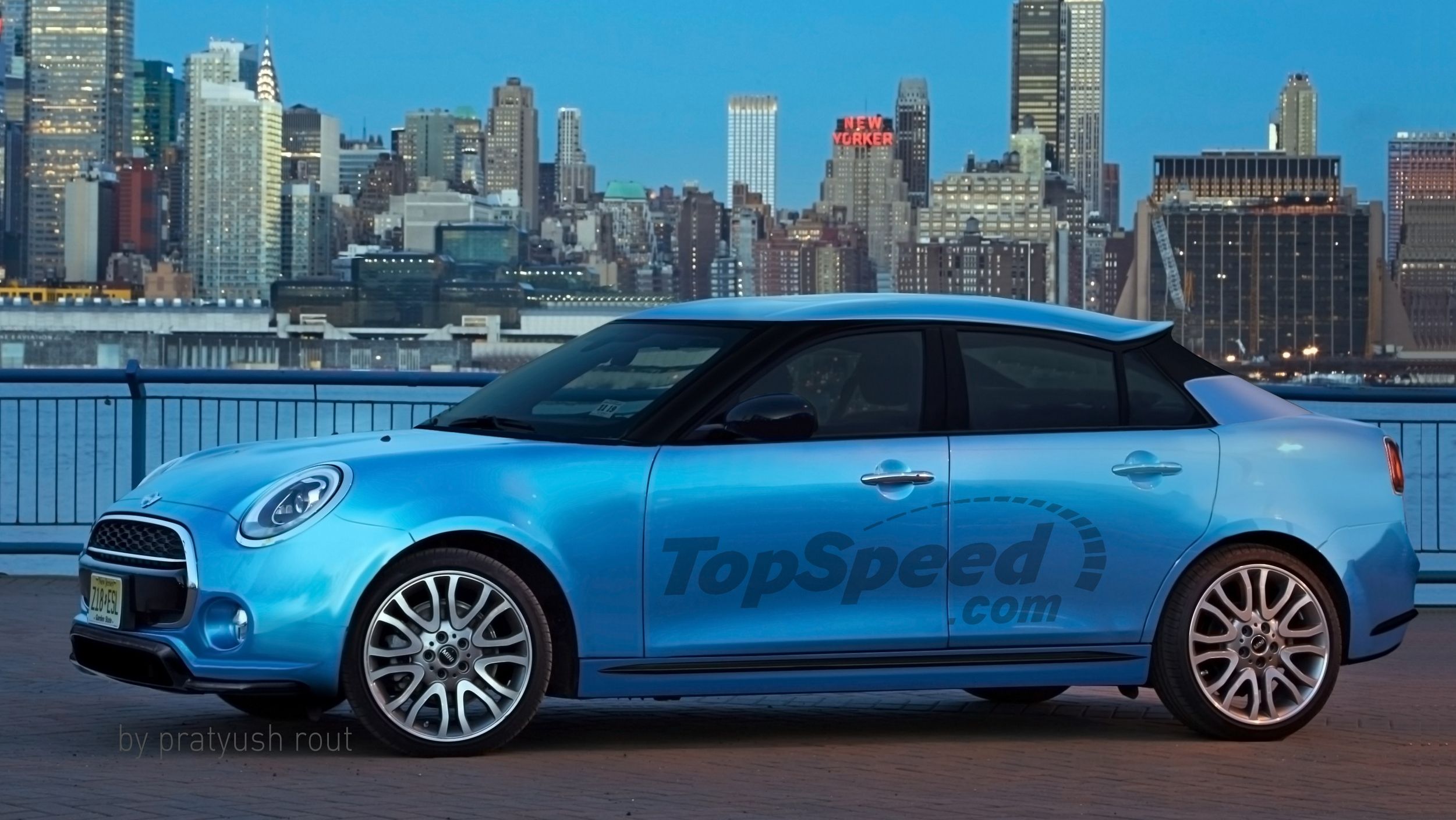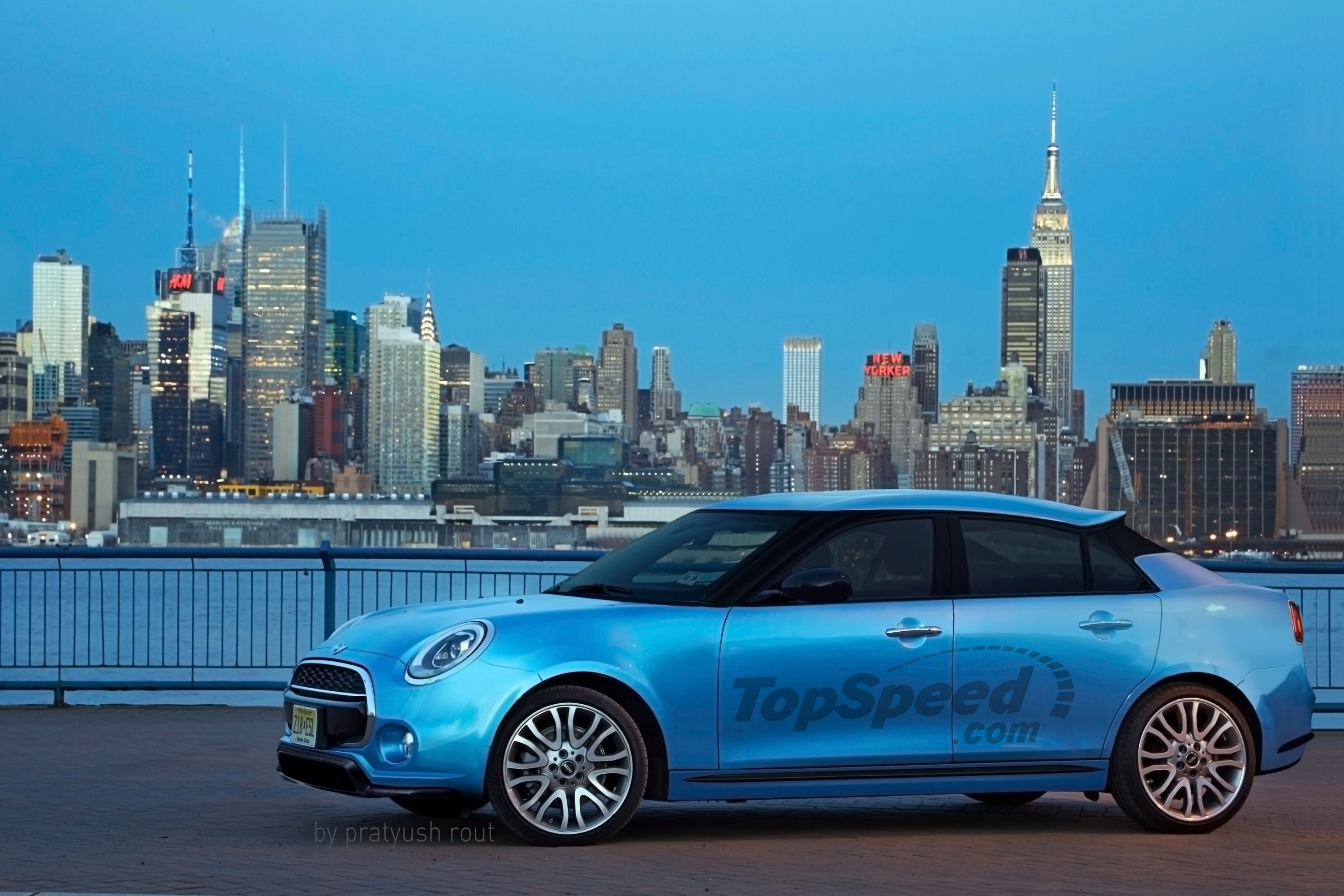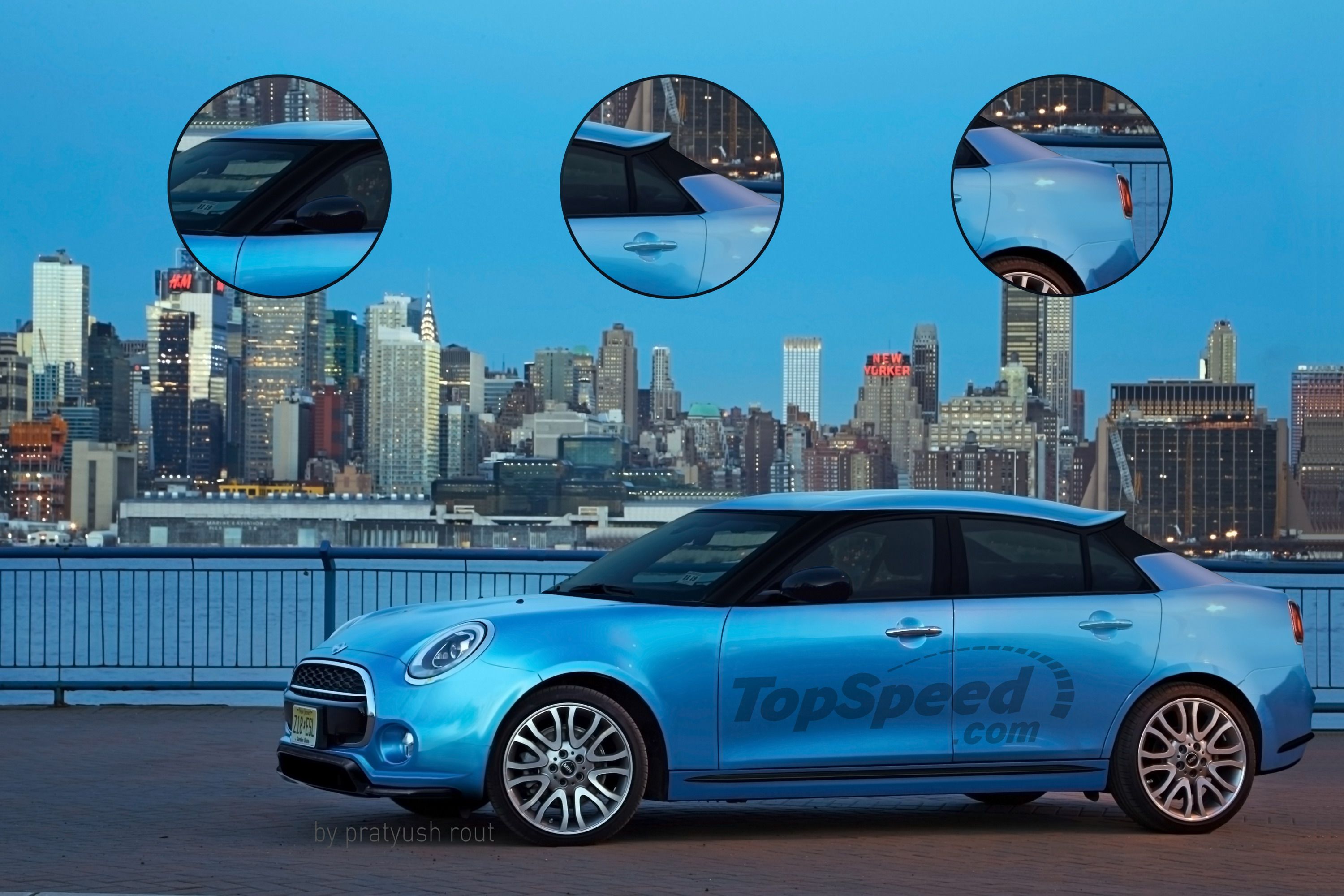Ever since Mini->ke57 was acquired by BMW,->ke178 the British motoring icon has struggled to grow. Once known simply as a provider of fun, accessible, small-sized transportation, the brand has made several forays into uncharted territory over the years, some of which have brought success, and others – not so much. Now, however, Mini says it has the right formula. Rather than offering myriad niche variants like it did in the recent past, Mini is looking to trim the fat to just five core model lines. Four of these are already known, including the hardtop, convertible,->ke144 Countryman->ke3615 subcompact crossover,->ke288 and Clubman->ke2526 five-door wagon.->ke143 The final fifth pillar, however, remains a mystery. That said, rumor has it a Mini sedan->ke142 is heading down the pipeline.
Supporting the speculation is a comment made by Ralph Mahler, vice president for product management at Mini, who dropped a hint at the New York Auto Show->ke226 while speaking to the U.K. publication Autocar about market trends, saying, “For example, in Asia and the U.S., the sedan segment is very big. This is very interesting to us, of course.”
In many ways, a new Mini sedan makes a lot of sense. The brand has applied its stylish, premium compact paintbrush to a variety of body styles before, but not once has it tried a classic four-door approach. And as Mini looks to expand its presence globally, this possible new segment entry could play well in markets where hatchbacks->ke304 lose traction, such as the U.S. and China.
So, if the rumors are true, what would a Mini sedan offer? Read on for our speculative review.
Continue reading to learn more about the upcoming Mini sedan.
2018 Mini Sedan
- Make: Array
- Model: 2018 Mini Sedan
- Segment: Array
- Engine/Motor: inline-3
- Horsepower: 134
- Torque: 162
Exterior
First things first – I am well aware that our rendering is going to be extremely polarizing. And that’s a good thing! Getting you to engage, dear reader, is what we’re all about, so let those opinions fly in the comment section.
But I’ll break it down for you like this – the Mini sedan was undoubtedly one of the most difficult renderings we’ve ever done. After seemingly endless back-and-forth discussion and countless iterations, this is what we’ve settled on.
The problem, as you may have guessed, stems from marrying a sedan roofline with Mini’s trademark rounded fascia. Making those two elements work together is no easy task, which makes this rendering a bit of a shot in the dark.
Let’s start in front, where we’ve drawn inspiration from the Mini Clubman. The most prominent feature seen here is the wide, chrome-lined grille, which uses a glossy black insert and gets split horizontally by an additional chrome strip and the bumper beam. Below this is a smaller lower intake, which comes bookended by twin fog lights. Mini’s characteristic rounded headlights sit against the fender line, drawing the eye straight back to the windshield.
Moving to the sides, we find front door handles that are covered in chrome, plus a strip of black cladding along the side skirts. The pillars are blacked out, creating a floating roof design, with the trailing edge ending in a slight upwards flick to give the rear end a little sportiness. The side view mirrors are also blacked out.
The rear end gets a short overhang and an even shorter trunk. The taillights are also from the Clubman, with a narrow design that wraps slightly into the rear quarter panel. Below is another black strip, which continues the lower character line originating from the lower insert in the front fascia.
Dimensionally, it’s expected the Mini sedan won’t be too much bigger than the Clubman, which would actually make it one of the smallest sedans on the market. And for a company called Mini, that’s a very, very good thing, even if the range has grown significantly compared to the original model.
Overall, you wouldn’t be faulted for saying our rendering looks a little… different. However, buyers presumably gravitate towards the Mini brand in order to stand out from the crowd, so maybe that’s a good thing too.
Interior
In a bid to distance itself from the toy-car persona that made it famous, Mini hopes to offer customers a more premium experience in the cabin. We’ve already seen this in the Clubman, and should the brand move forward with a sedan, it’s safe to assume we’ll find a similar approach – possibly going even further.
With that in mind, I wouldn’t be surprised if the Mini sedan was equipped with a similar interior spec as the upscale Clubman. To start, materials used would include leatherette and polished metal, with real leather, piano black trim, and wood trim making the options list. The three-spoke steering wheel would come covered in more animal skin, and get contrast stitching as standard. Buyers should be able to choose from a variety of colors and customization options, ranging from the seat upholstery, to the headliner, to the door inserts. Carbon-fiber trim would be offered for those looking for a splash of performance flavoring.
The dashboard would get the same look and layout as the Clubman, with a simple gauge cluster behind the steering wheel and squared-off air vents. Sitting high and central on the console, the characteristic circular infotainment surround would remain – even though it is a bit cartoonish, I can’t see Mini straying too far from fun features like this one. More polished metal would be used for the HVAC controls.
Seating capacity would be capped at five passengers, while trunk space would be enough to fit not much more than a few grocery bags. In fact, I wouldn’t be surprised if Mini sacrificed cargo room for more interior space, leaving one of the hatchback models as the correct choice when it comes to practicality.
Drivetrain
If Mini does decide to create a sedan, odds are it won’t have the time to create a new drivetrain to power it. That means it should come with the same selection of turbocharged gasoline engines as the Clubman.
Starting things off will be a 1.5-liter three-cylinder offering up 134 horsepower and 162 pound-feet of torque. Higher trims (a.k.a., the “S” model) will get a 2.0-liter four-cylinder with 189 horsepower and 207 pound-feet of torque. A six-speed manual gearbox will come standard, while a six-speed automatic will be an available option for the three-cylinder. The 2.0-liter will offer an optional eight-speed auto box. Standard trim will be FWD, while AWD will also be available on the “All4” spec. A sprint to 60 mph will take around 9 seconds in the entry-level models, and 6.5 seconds for the higher spec. Top speed will be around 140 mph.
Under the sheet metal will be BMW’s UKL architecture (UKL stands for “untere klasse,” which is German for lower class). The UKL platform has two derivatives – UKL1 and UKL2, with the latter underpinning the Mini Clubman, BMW 2 Series Active Tourer, BMW 1 Series, BMW X1, and presumably, the Mini sedan.
When it comes to handling, I could see the sedan taking on a more luxury-oriented approach, with softer suspension tuning and a cushier ride compared to the other model lines, which would make the sedan the most mature offering in the Mini stable.
Prices
If Mini decided to offer its sedan as a more affordable four-door similar to the rest of its model line, it would probably start in the $23,000 to $25,000 range. However, given the brand’s interest in offering a more premium selection of automobiles, I wouldn’t be surprised if the sedan instead took on the role of being Mini’s “halo” car, with copious technology and luxury, plus a larger price tag. If that were the case, I’d expect a base MSRP of just under $30,000, which means the three-cylinder engine options would most likely get the axe.
Either way, expect to see a concept of the Mini sedan some time in the next year.
Competition
Acura ILX
Assuming a high-end approach for the Mini sedan, Acura would offer a fair amount of competition with the ILX. Based on the Civic, the ILX adds prestige to the H-Badge favorite with a variety of technological and luxury amenities. Dimensionally, the Acura would be a fair bit larger than the Mini, but that could play to the Mini’s advantage in congested urban environments. The ILX starts at $28,000.
Read the full review here.
Mazda 3
At the other side of the affordability equation, the Mazda 3 would be a fun alternative to the Mini, with slick styling, a peppy selection of four-cylinder engines, and nippy suspension tuning. Like the ILX, the Mazda is bigger than the Mini, but by a smaller margin than the Acura. Pricing starts at just under $18,000.
Read the full review here.
BMW 1 Series Sedan
Produced since 2004, the BMW 1 Series has been offered in several different body styles, and now, it looks like it’ll get the four-door treatment as well. Expected to arrive some time in 2016, the 1 Series sedan will probably get the same engines and underpinnings as the Mini, while high levels of cabin appointment will solidify its place in the same segment if Mini decides to go high-end. However, outside will be characteristic Bimmer styling, making for a safer choice when it comes to aesthetics. Pricing is expected to start at just over $30,000.
Read the full review here.
Conclusion
Some could see a new, opulence-oriented sedan from Mini as yet another step away from the brand’s original goodness, further proof that it has lost its way in some never-ending quest to scoop up new customers. And while it’s true that Mini’s lineup has grown larger and more “normal” over the years, a comfortable sedan wouldn’t be entirely out of step with the brand’s history. Take the Riley Elf and Wolseley Hornet as good examples of this. Both were Mini variants released in the ‘60s, and each gained an elongated rear and more luxurious appointment.
In his conversation with Autocar, Ralph Mahler even mentioned these old-school Minis, saying, “The sedan concept is in our history. So we have roots there. We have to look at it in a factual way. Customers may know of the strong heritage of the sedan concept, but it was never big volumes. Most customers would hardly know that, so would they link to heritage?”
Probably not. Even if the sedan used the Riley nameplate (BMW actually owns the trademark after acquiring the MG Rover Group in 2000), odds are most enthusiasts would dismiss such a vehicle.
But the real question is this – would the general public feel the same way?
I’m not so sure. I could see a well-appointed executive Mini compact fairing quite well, if (and this is a very big if) it offered just the right amount of quirkiness. There are plenty of serious luxury cars out there for around $30,000, many of which come from Germany. Could BMW do the same thing, but add the veneer of British humor?
I don’t see why not. And if that turns out to be the case, there could be a Chinese-exclusive long-wheelbase Mini sedan called the Riley arriving sometime in the near future. Weirder things have happened.






